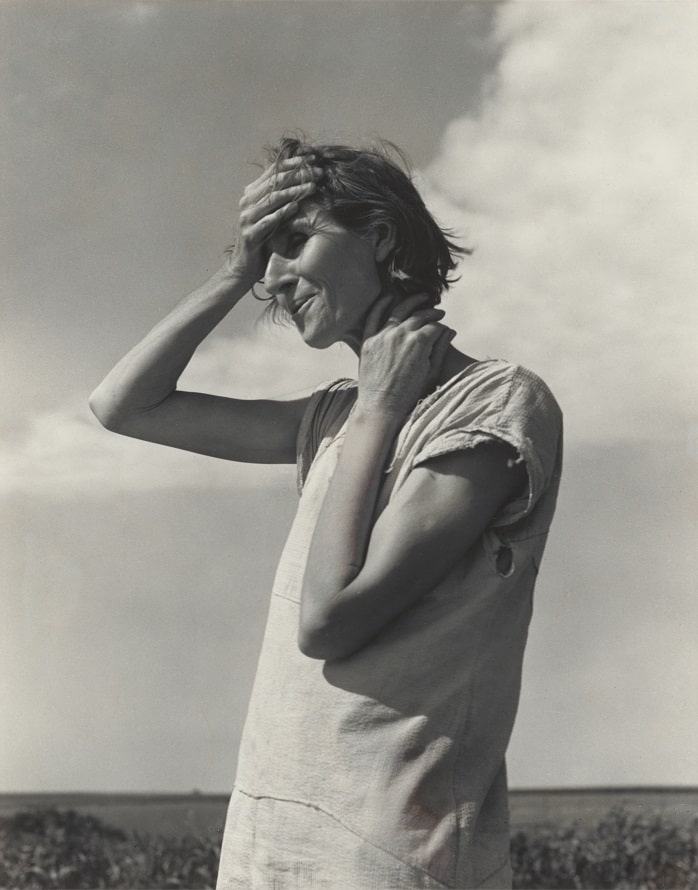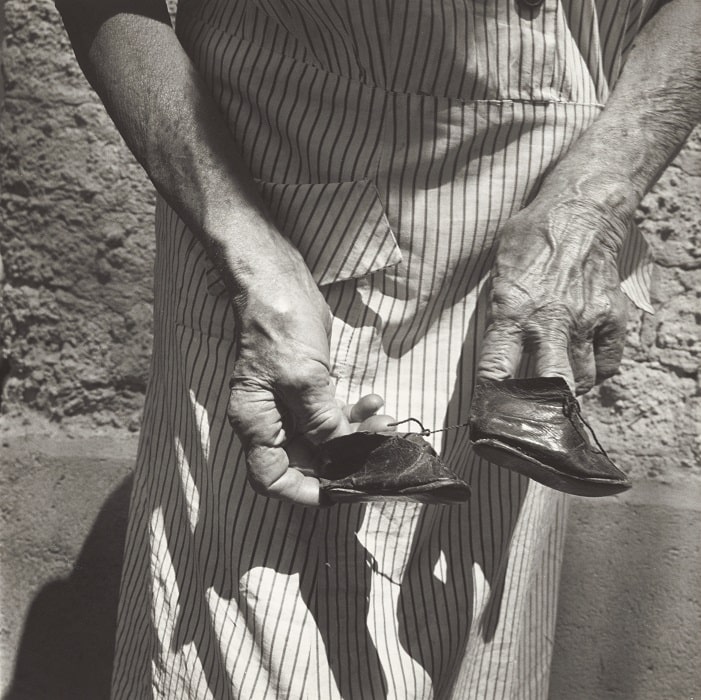Dorothea Lange’s exhibition at the National Gallery of Art in Landover, Maryland “Seeing People” explores how Lange’s portraits have shaped our understanding of documentary photography today and what significance they had for her vision and creative practice. Divided into six thematic sections, the exhibition starting in early November 2023 features portraits ranging from her early career as a studio photographer in San Francisco – the earliest work dates from 1919 – to her powerful coverage of the Great Depression and expressive photographs of everyday people and communities in the 1950s and early 1960s.
Abb. oben: Object ID: 5558-075 – Dorothea Lange. Country store on dirt road. Sunday afternoon. Note the kerosene pump on the right and the gasoline pump on the left. Rough, unfinished timber posts have been used as supports for porch roof. Black men are sitting on the porch. Brother of store owner stands in doorway, Gordonton, North Carolina, July 1939, printed later, gelatin silver print, image: 24.5 x 34.3 cm (9 5/8 x 13 1/2 in.) sheet: 25.6 x 35.4 cm (10 1/16 x 13 15/16 in.) mat: 16 x 20 in. frame (outside): 17 x 21 in. National Gallery of Art, Washington, Gift of Daniel Greenberg and Susan Steinhauser
Works on display include portraits of Native Americans in Arizona and New Mexico from the 1920s and early 1930s, later depictions of striking workers, migrant farm workers, rural African Americans during the Jim Crow era, Japanese Americans denied civil rights during World War II and post-war baby boomers, as well as portraits of people in Ireland, Korea, Vietnam, Egypt and Venezuela that Lange made in the decade before her death in 1965.
Lange began her career as a commercial studio photographer in San Francisco in 1918, and her studio became a meeting place for artists who engaged in serious discussions about photography and art. In 1920, she married Maynard Dixon, a painter of Western subjects, who encouraged Lange to take her photography outside. She accompanied him on trips through the American Southwest, photographing rural landscapes and Dixon at work, as well as the indigenous communities he portrayed.

She began working in the streets of San Francisco in 1933, taking photographs such as White Angel Breadline, San Francisco, California (1933), which captured the impact of the Great Depression and the plight of the city’s dispossessed men and women. Lange also photographed union organisers and demonstrators at May Day events around the Civic Center Plaza in San Francisco: she focused on the demonstrators speaking, listening or holding signs, promising to produce prints within 24 hours, as in May Day, San Francisco, California (1934). She also documented the strikes that followed, creating portraits of speakers and demonstrators with placards and photographs of police presence in works such as Street Demonstration, San Francisco (1934). When she met labour economist Paul Schuster Taylor in 1934, Lange began photographing the plight of migrant farmers who had moved to California from the South and Midwest in search of a new livelihood.

From 1935 to 1943, while working for the US Resettlement Administration, the Farm Security Administration and the War Relocation Authority, Lange focused on the resilience of Depression-era families, farm workers, rural cooperatives, migrant camps and the forced incarceration of Japanese Americans in the early days of World War II. The resulting images illustrate the human and economic impact caused in the United States by farm leasing, racism, the legacy of slavery, climate change and migration movements. These portraits, sometimes combined with interviews, added a personal element to Lange’s stark images of makeshift dwellings and agricultural fields and solidified her documentary style.

During the Second World War, Lange created one of her most impressive series for the War Relocation Authority, depicting the forced incarceration of Japanese Americans in California at Manzanar. Works on view include Grandfather and Grandson of Japanese Ancestry at a War Relocation Authority Center, Manzanar, California (July 1942). She also photographed the changes in California’s social fabric as the emerging economy – driven by the growing arms industry – drew African Americans from southern states and women into previously male-dominated and segregated industries such as shipbuilding. Throughout the 1950s, Lange continued to work on stories about people and their communities, both for personal projects and for Life magazine, which included her first photographs from Europe. Asia, South America and North Africa.
WHERE?
National Gallery of Art Landover
2000 South Club Drive
Landover, MD 20785
Maryland
USA
WHEN?
Sunday, 05.11.2023- Sunday, 31.03.2024
Daily, 10:00-17:00






